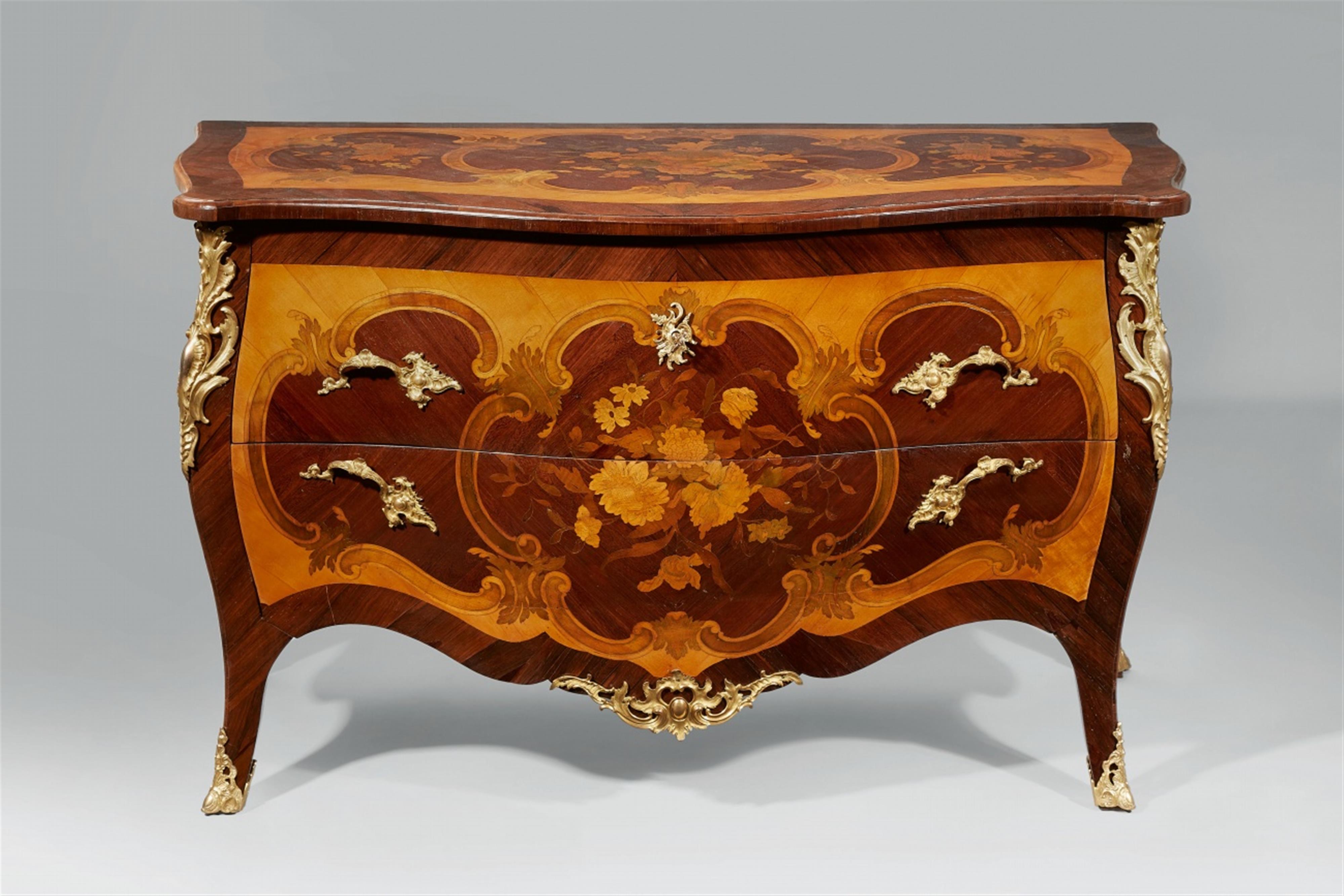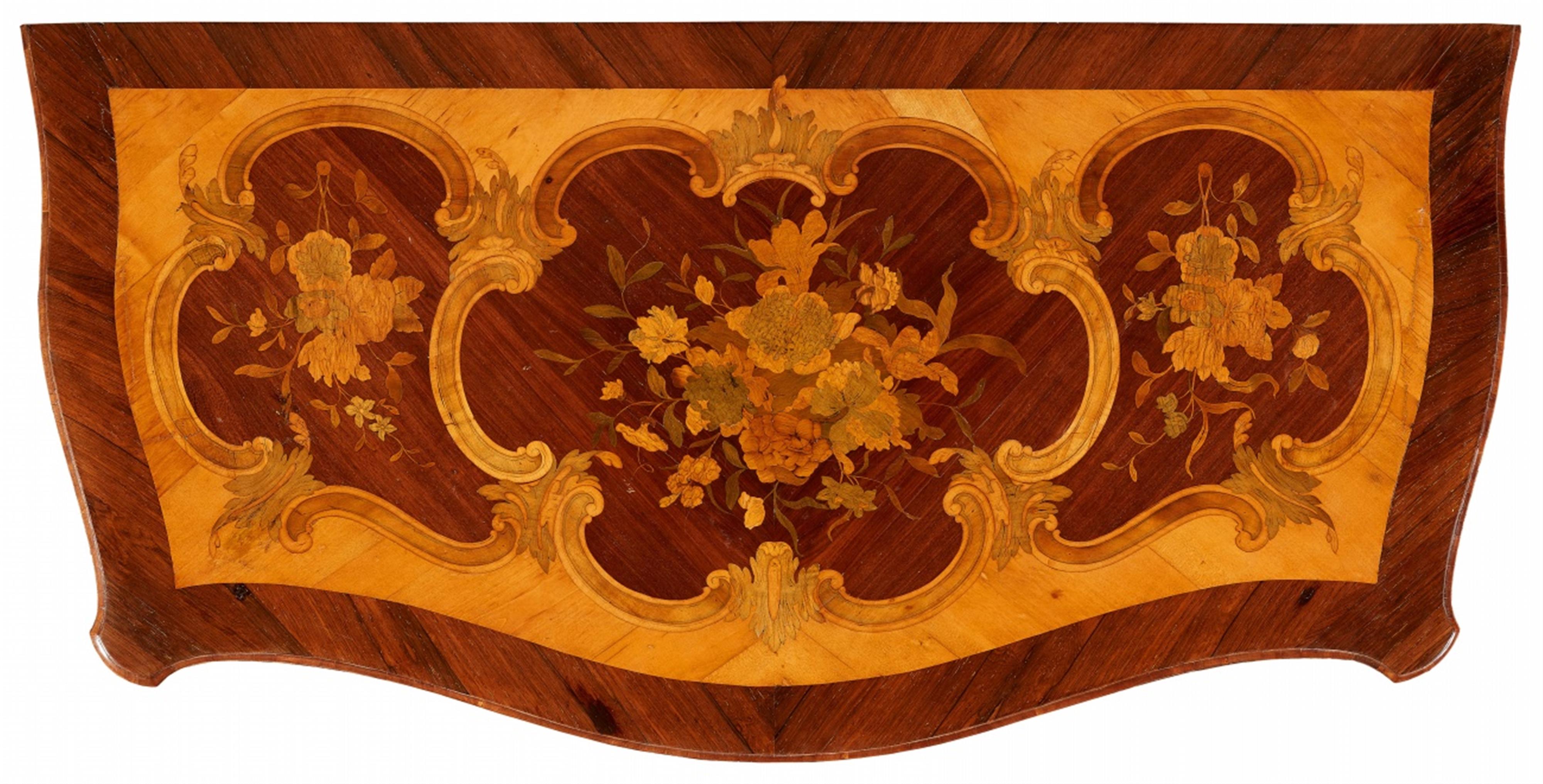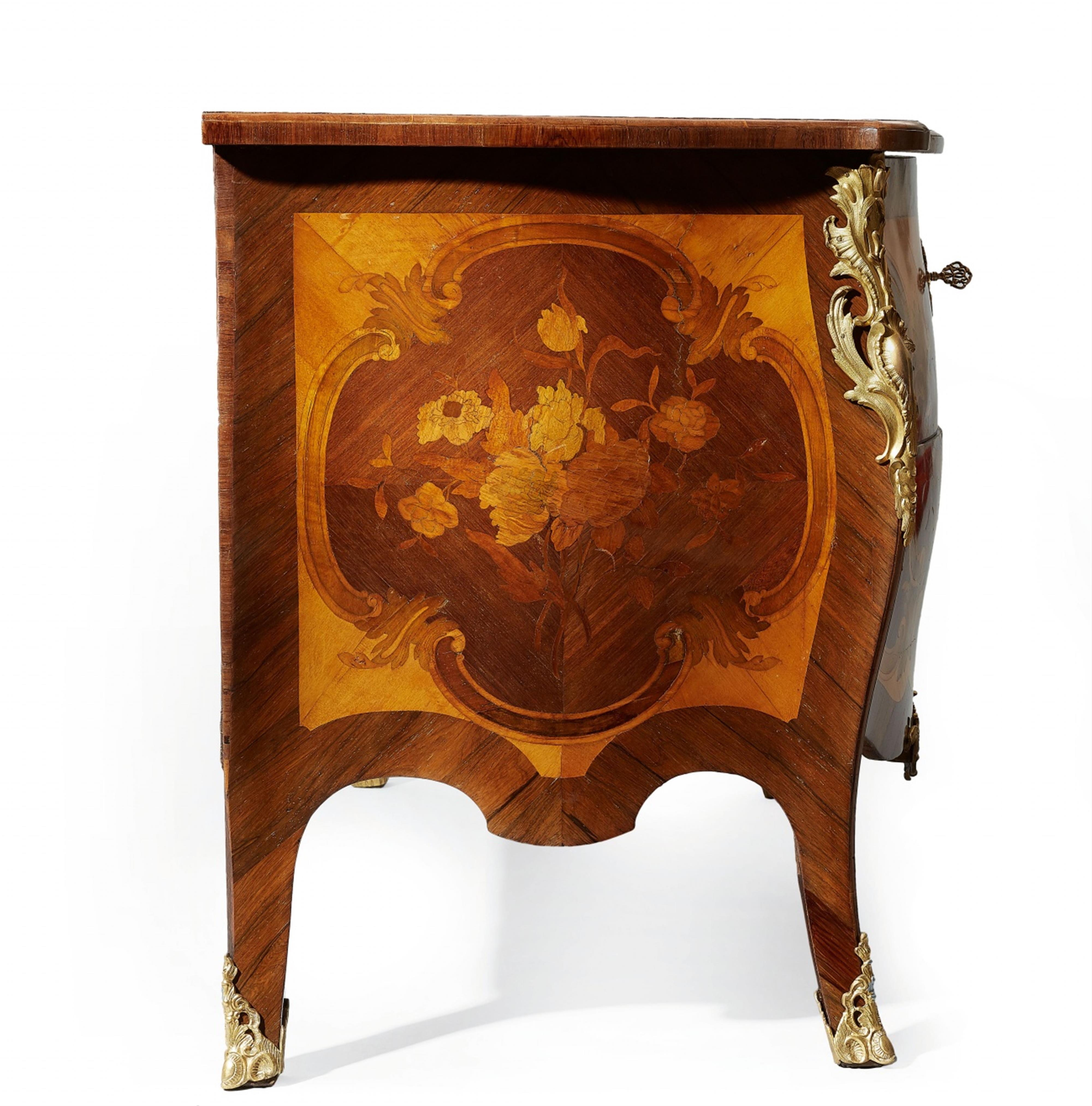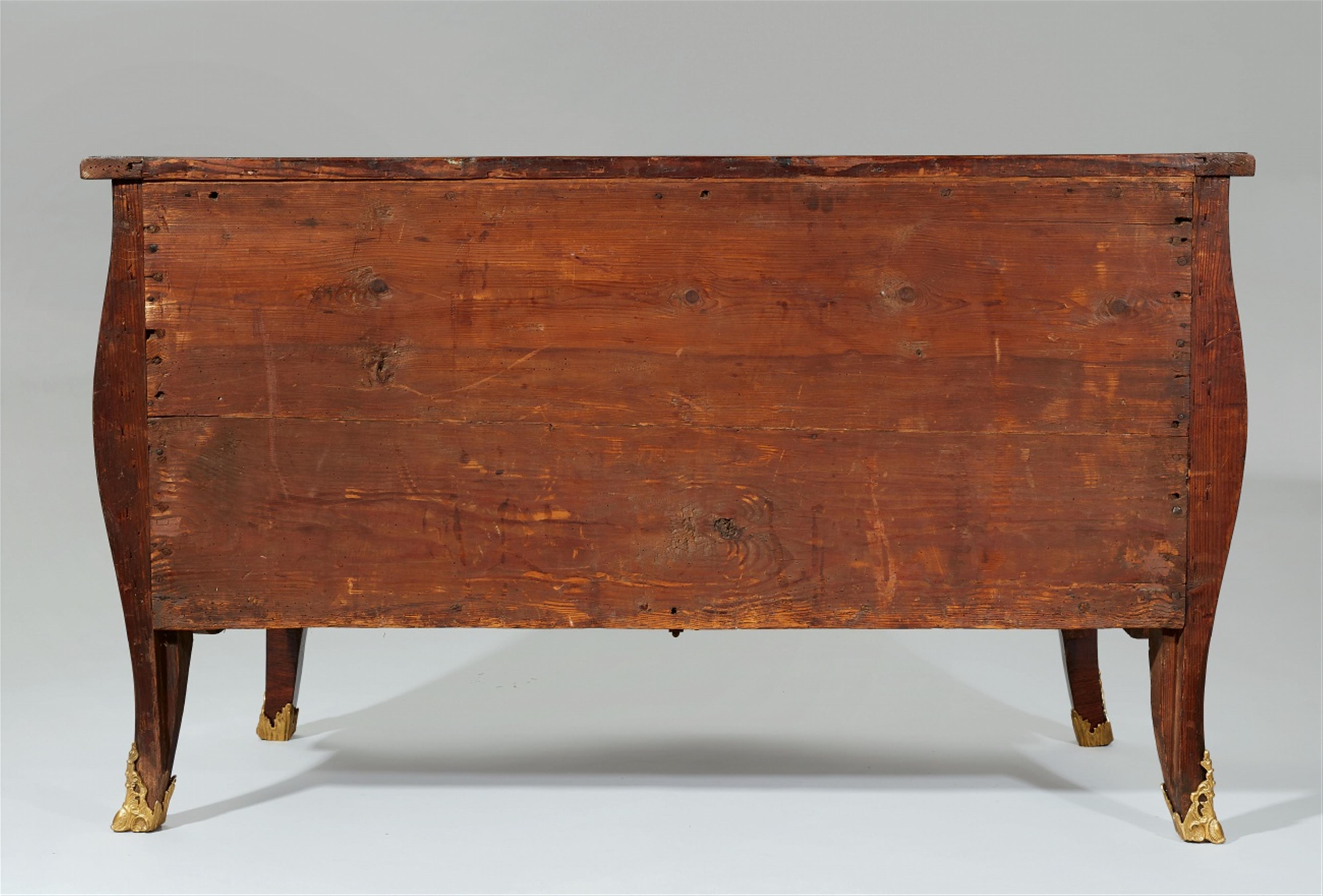A chest of drawers attributed to the Gebrüder Spindler
Kingwood, rosewood, maple, and coloured wood veneers, partially engraved and with black contours, on softwood, ormolu mountings. Two-drawer bombé-form corpus with flat back on short flaring supports. The top and front decorated with characteristic three-part rocaille motifs, the sides each with a central cartouche filled with floral decor. The top drawer containing the lock. The lockplates and key replaced. H 81.3, W 136.5, D 67.5 cm.
Bayreuth, attributed to Johann Friedrich and Heinrich Wilhelm Spindler, circa 1760.
A similar version of this magnificent model with its dark surround and opposing grain veneers to the drawers was used later in Potsdam in 1763. The Prussian work is additionally enriched by the use of corresponding cartouche form ormolu mountings. Another chest of drawers of this design, built in 1767 and using an oak corpus, was taken to Haus Doorn by the last Emperor(Sangl, ibid., fig. 12 and 14).
From Bayreuth to Potsdam
The Spindler Brothers and their career
Friedrich II began with the realisation of his plans for the Neue Palais directly after the end of the Seven Years' War. The arrival of Johann Friedrich Spindler in Berlin in 1763 and his half brother Heinrich Wilhelm Spindler in 1765 was a happy coincidence. The two cabinetmakers from Bayreuth worked in a style that closely suited the king's personal preferences. In Friedrich's own design for a KPM service, every plate, tureen and cup is decorated with flowers, cartouche motifs and trellis designs, and the furniture of the Spindler brothers reflects these same motifs in their inlaid surfaces. Like the porcelain of KPM, they too became emblematic of the Prussian Rococo. The finely wrought and naturalistic floral marquetry is a far cry from the schematic designs of their counterparts in Paris, a fact which Ulrich Leben attributes to the influence of the French ornament engraver and painter Jean Pillement. The Spindler brothers were entrusted with the furnishings of Friedrich's study in Potsdam, as well as the marquetry cabinet in the rooms of his brother Prince Heinrich. They built numerous fanciful chests of drawers, one of which the last Prussian emperor even took with him into exile in Haus Doorn.
Their very first royal commission, a chest of drawers with a parrot motif made around the year 1765, already presents an impressive testimony to brothers' talent. They soon acquainted themselves with the high standards of the victorious Prussia and began to produce far more ambitious designs than any of those made for Margravine Wilhelmine in Bayreuth. At court they were permitted to use the most costly materials: Tortoiseshell, mother-of-pearl, ebony, and amaranth, and there was infrastructure in place which allowed them to work closely with other exceptional craftsmen, such as the bronze caster Johann Melchior Kambly. They could thus become part of a larger creative collaboration embarked upon by many of the best artists of their generation.
Apart from the works by the Gebrüder Spindler in Potsdam which were published by Henriette Graf, only very few important examples have survived in private ownership and in international museums. Ulrich Leben describes in detail the opulent tortoiseshell inlaid table attributed to Kambly and the Spindler brothers in the Rothschild Family Trust. The Museum of Metropolitan Art in New York houses a table of similar design with wood inlays from the bequest of Emma A. Sheafer (inv. no. 1974.336.223) which is probably the same piece listed by Kreisel in 1970 together with another work, both of which were acquired on the art market in Munich. The brothers presumably first developed the design of this table in Potsdam based upon Parisian models. The upper leaf can be lifted up via a large curved hinge to reveal an additional leaf beneath with floral marquetry and diagonal veneer, whilst the apron is divided into four sections. A small decorative table made by the French ebenist François Bayer in 1763 located in the Ansbach Residence shows surprising similarity to the Spindlers' design.
The career of the Spindler brothers began in their hometown of Bayreuth. Johann Heinrich, who was born in 1726, and his half-brother Heinrich Wilhelm, twelve years his junior, were both in the services of Margravine Wilhelmine until her death in 1758. Sigrid Sangl published the Bayreuth oeuvre of the two young cabinetmakers in 1992, and the two chests presented here can almost certainly be attributed to this earlier phase. By this time, they had already developed the later Spindler style that would become so popular at the Prussian court, with marquetries of exceptional fineness decorating the surfaces of otherwise simple bombé form designs.
The influence of French furniture-making under Louis XV is clearly evident. It was Heinrich Wilhelm who made his way to Paris in 1756 during the itinerant period stipulated by the cabinetmakers' guild, and he remained there for a short time in the workshop of Pierre Migeon II. Migeon was responsible for much of the furniture used by the French court at the time, especially by Madame Pompadour. His marquetries are characterised by their lively changes of grain, and the fronts of his bombé form cabinets are often decorated with large cartouches sans travers. Pierre Kjellberg mentions in particular a small bureau de pente inlaid with a landscape after a motif by Pillement. It is thus highly likely that the young Heinrich Wilhelm gathered plenty of inspiration for the later “Spindler style” during his time in Paris, as the present two pieces demonstrate. Despite this, the two ebenists still managed to develop their own unique formal repertoire as early as 1760, combining elements of the Main-Franconian Rococo style with Parisian elegance. It was with this surprising but impressive combination that the brothers were able to attain a reputation in Germany matched only by that of the Abraham Roentgen studio.
Provenance
Private collection, Westphalia.
Literature
Cf. Kreisel, Die Kunst des deutschen Möbels, vol. 2, Munich 1970, illus. 788 ff.
Cf. Sangl, Spindler?, in: Journal of the Furniture History Society, Leeds 1992, vol. XXVII, p. 22-66.








